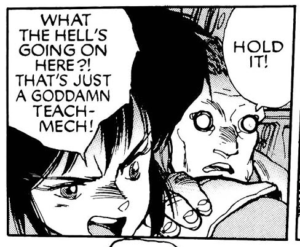For an AI-related movie, I watched the anime version of Ghost in the Shell, a late 20th century vision of five years from now. I hadn’t watched or read it before, so it was about time. I noticed echoes of Bladerunner, RoboCop and The Matrix. The film was based on a manga which seems to unwittingly comment on our current situation.

image from Ghost in the Shell by Masamune Shirow
and also echoes Darwin Among the Machines from 160 years ago:

image from Ghost in the Shell by Masamune Shirow
Beyond the thematic references, I was interested in the philosophical musings on evolution, life and humanity. The hero of the story is a cyborg, essentially a robot with a human brain. Is she then human? She’s not so sure:
Major Motoko Kusanagi: Well, I guess cyborgs like myself have a tendency to be paranoid about our origins. Sometimes I suspect I am not who I think I am, like maybe I died a long time ago and somebody took my brain and stuck it in this body. Maybe there never was a real me in the first place, and I’m completely synthetic like that thing.
Batou: You’ve got human brain cells in that titanium shell of yours. You’re treated like other humans, so stop with the angst.
Major Motoko Kusanagi: But that’s just it, that’s the only thing that makes me feel human. The way I’m treated. I mean, who knows what’s inside our heads? Have you ever seen your own brain?
Batou: It sounds to me like you’re doubting your own ghost.
Major Motoko Kusanagi: What if a cyber brain could possibly generate its own ghost, create a soul all by itself? And if it did, just what would be the importance of being human then?
And that refers to the AI in the film, the Puppet Master
Puppet Master: It can also be argued that DNA is nothing more than a program designed to preserve itself. Life has become more complex in the overwhelming sea of information. And life, when organized into species, relies upon genes to be its memory system. So man is an individual only because of his intangible memory. But memory cannot be defined, yet it defines mankind. The advent of computers and the subsequent accumulation of incalculable data has given rise to a new system of memory and thought, parallel to your own. Humanity has underestimated the consequences of computerization.
quotes from https://en.wikiquote.org/wiki/Ghost_in_the_Shell_(film)
Could we draw a parallel between GPT and DNA? I’m out of my element here of course, but I see in both an encoding of the existing and the production of something new. The issue of memory is significant too. We used to preserve memories with film photography. This had imperfections, but was based on physical reality. The photos I take with my phone are mediated through algorithms, and have been known reinterpret reality.
So I asked our teach-mech Dr. Oblivion, “How does the vision of artificial intelligence presented in Ghost in the Shell hold up in the present day?”
includes sample of Ghosthack from Ghost In The Shell (1995) OST
I think if I asked a better question, I might have gotten a better response. AI apps aren’t known for insight, and sometimes give us the most obvious string of words. Will our AI future be dystopian, or just disappointing?
The doctor does touch on an important point. We built the internet in order to augment human intelligence. Around the time of Ghost in the Shell, we opened it up to commercial exploitation, and a few people became unimaginably wealthy. For the past couple decades, more and more it’s been developed as a tool for social control. So who is the web for? Who is AI for? In ds106 we all have our own little pieces of the web, as it was meant to be. Entities like Alphabet and Amazon and Meta and Microsoft come along like Columbus and plant a flag in it and claim it for their own. Do we go along with that, or do we want open, public infrastructure? The easy path may not be the most rewarding.












